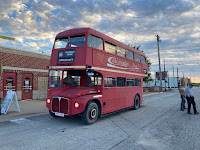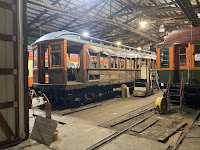Niles's Finest: Lake Shore Electric 150by Art Peterson
All photos are from the Krambles-Peterson Archive and may not be reproduced without permission
Headline image: Cars 150 and 155 sit on the siding at the LSE Cleveland station in this undated view. Car 150 is signed for Beach Park, about 20 miles west of Cleveland. This had been a major attraction for LSE riders in pre-auto days. As a reflection of its importance to the railway, a two-track storage barn, along with a single-track inspection barn was located here. The car also has its storm windows fitted, as well as a “rear view mirror” visible on the nearest corner post. The metal fender was a Detroit requirement, dating from the through-operation of these cars to/from the Motor City.
The Lake Shore Electric (LSE) was the creation of Cleveland’s Everett-Moore financial syndicate, a consolidation of four companies dating to August 29, 1901. LSE served the populous Cleveland-Toledo area of Ohio, with significant access to the Lake Erie beaches and other recreational havens. The original alignment hugged the lake shore for 45 miles from Cleveland west to Ceylon Junction and then dipped inland to serve Norwalk, Bellevue, Fremont, and Woodville on its way to Toledo. On July 21,1907, LSE opened the Sandusky-Fremont direct line, which not only increased the miles of line along the lake front, but also shortened the Cleveland-Toledo mileage by about five miles while shaving 30 minutes off the end-to-end running time.
With an expanding traffic base, as well as more miles of line to run, LSE turned to the Niles Car & Manufacturing Company for a batch of 10 straight coaches numbered between 150 and 159. The order was placed in December 1905 and the first of these cars arrived on the property on May 28, 1906, with all 10 received by mid-June of that year. These cars had classic wood car architecture, with arched end windows, curved upper sash windows, and a railroad roof. The cars were also equipped for multiple-unit (MU) operation, which was not the norm for interurbans of the day. As it happened, LSE was prohibited from running multiple-car trains within the Cleveland and Toledo city limits at the time.

This unidentified LSE Niles coach will have to stand in for the as-built appearance of IRM’s car 150. In 1910, LSE had grown to 145.5 first track miles, along with 19.4 miles of second track. A total of 534 employees worked for LSE, with 278 of these engaged in providing transportation. The Niles cars were equipped with GE Type M MU control and used C36 master controllers. Four Westinghouse No. 121 motors, each producing 85 HP, were used on the 150-series cars. LSE would begin MU service with the Niles cars during 1910, outside the limits of Cleveland and Toledo. This photo shows the original Van Dorn couplers, which were later superseded by heavier-duty MCB couplers.
Niles had a reputation for turning out fine-looking wood cars, including their “Electric Pullmans” for Oregon Electric and the Washington Baltimore & Annapolis (among others), as well as multiple orders for the Chicago Aurora & Elgin. Like the CA&E, LSE must have liked what Niles produced, for in 1907 they went back for another 15 cars, this time including five combines and 10 coaches. With the second order on the property, LSE now had 19 straight coaches (car 152 was an early casualty) and the five combines.
From 1912, having resolved their multiple-car train issues with Cleveland and Toledo, LSE and Detroit United (DUR) were now running multiple-car Cleveland-Detroit trains, using cars from both lines in-train. DUR had also turned to Niles for cars and, in four orders between 1912 and 1915, amassed a fleet of 24 coaches. By 1915, LSE was carrying 5.2 million passengers annually. A 1927 survey of the property found that LSE rostered 187 cars, with an average age of 10 years. LSE had turned to Jewett for its steel-bodied (but still truss-rod-equipped) cars, buying three each in 1915 and 1917, followed by a nine-car order in 1918. The steel cars took over the premiere runs on the system, though there were still plenty of assignments for the older cars to handle. This survey was done around the time that Cities Service purchased control of the LSE from the Everett-Moore Syndicate on March 23, 1927.
Coincidentally, 1927 was the first year that the LSE interurban operations posted a deficit. Sadly, this situation would not change through the end of interurban operations in 1938. During both 1932 and 1933, LSE’s deficits reached $500,000. In 1932, LSE defaulted on its interest payments and was forced into bankruptcy. Frederick Coen, the long-serving Vice President and General Manager of the railway, was appointed as receiver.

LSE car 150 presented this appearance later in its life. Most of the older LSE cars maintained a respectable look up to the end of service. End windows had been squared, the electric markers above the front-end windows had been removed, and Tomlinson MCB knuckle-type couplers were installed on these cars. The electric coupler was a model DA-82-B for the control circuits and a model DA-35-E for the bus line. This shot manages to capture the glow of the 23-watt interior lights in the clerestory windows. We are indebted to the LSE’s “Car Inventory Record” sheets for recording the interior light bulb wattage.

The interior of car 149 from the 1907 order will have to suffice for the appearance of the 150-series of cars. Coaches from both Niles orders seated 52 and were finished in cherry wood with inlaid white holly borders. Black leather-covered seats from Hale & Kilburn were provided. Also evident is the partial Empire ceiling used on the Niles cars, where the carlines are arched, but the alcoves for the clerestory windows are simply squared off. A car with a full Empire ceiling would have had arched clerestory window alcoves following the curve of those windows.

Car 150 is facing west on State Street near Arch Street in Fremont on August 16, 1936. Fremont was 84 miles from Cleveland and was west of Sandusky Junction where the original line and the direct line re-joined to run on to Toledo. Behind the car is the Hotel Fremont. The earliest parts of this hotel dated to the Croghan House of the 1840s. Sadly, the Hotel Fremont was destroyed by fire in March 1981. The town of Fremont dates to the 1849 renaming of Lower Sandusky in honor of the man who secured California for the US. Credit Ralph Perkin for this atmospheric shot.
Throughout the early 30s, as its connecting traction lines succumbed, LSE was steadily declining in terms of both freight and passenger traffic. As recently as 1929, freight traffic on the LSE had accounted for 48% of the line’s gross revenue. LSE freight handlers went on strike on May 15, 1937. Management responded by immediately ending all LSE freight service. All of LSE’s physical property was sold to Toledo Edison in March of 1938. The cars were never relettered to reflect the new owner, running with the LSE name on them until the last day on May 15, 1938.

Ralph Perkin also took this shot of one of the 1915 Jewett steel cars working a direct line Express trip connecting with the 150, ready to head to Norwalk on the old line. This photo was taken on April 17, 1937. An express could get you to Ceylon Junction in 1 hour, 35 minutes. LSE’s Limiteds were three minutes faster than the expresses, equating to an average speed of 29.1 mph. A local on the mainline required 1 hour, 50 minutes for the 45.1-mile trip. Through trips were still being run on the old line. From November 15, 1937, service on the original line would be interrupted at Bellevue (west of Norwalk).
After LSE (TE) disposed of the rolling stock during 1938, car 150 became a house in Milan, OH. It remained there until 1964, when it was moved to Fostoria, OH. It continued in use as a dwelling until 1977, when it was bought and moved to Station Square in Pittsburgh. In this guise, it sat on a pair of CTA 4000-series Baldwin trucks acquired from IRM. At Station Square, LSE 150 was displayed along with an ex-Brooklyn semi-convertible car shell. For a while, car 150 was used as a flower shop. In 2000, the former P&LE station was redeveloped, at which time car 150 was sold to the Pennsylvania Trolley Museum. They resold the body to IRM and ended up trading the 4000-series trucks to a museum near Rochester. Car 150 has been on display at IRM since its arrival in Union in late 2000 and was repainted in LSE colors during 2005-06.
We'd like to extend our sincere thanks to Art Peterson for writing this article and sourcing these wonderful images of car 150 in service. For more information on car 150, read our 2012 write-up about the car here. Frank Hicks helped with editing for this article.






















































